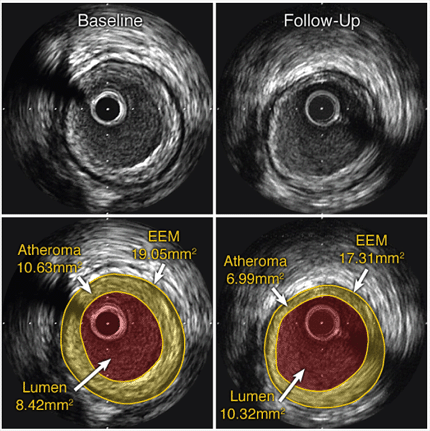The ASTEROID Trial reported in 2006 examined the effects of LDL cholesterol reduction using the statin drug, rosuvastatin (Crestor), with coronary atherosclerosis quantified and tracked with intracoronary ultrasound. The Track Your Plaque report, New study confirms: LDL of 60 mg reverses plaque, on the ASTEROID Trial provides commentary on the results.
Though I remain skeptical that a statin-only treatment strategy can reverse coronary plaque in the majority of people, I do believe that the AstraZeneca-sponsored ASTEROID Trial does add to the wisdom on heart disease management. More importantly, it has served to raise awareness among both the public and my physician colleagues that atherosclerosis is indeed a potentially reversible condition.
Specifically, the ASTEROID results confirm that, either directly or indirectly, LDL cholesterol reduction achieved with statin agents does correspond to increasing degrees of plaque reversal. The mean (calculated) LDL cholesterol achieved in ASTEROID was 60 mg/dl, the same as the Track Your Plaque suggested LDL target.
Though the ASTEROID Trial is not news, I stumbled on a chart posted on the ASTEROID Trial website that clearly highlights how a number of other studies beyond ASTEROID have fallen into this pattern:

The graph reveals a linear relationship : The greater the reduction in LDL cholesterol with statin drugs, the greater the plaque regression ("change in percent atheroma volume"). (Several other studies not included in the graph also cluster into the same linear relationship.)
I am no supporter of drug companies, nor a defender of their policies and practices. But I do believe that their data can serve to teach us a few lessons. For instance, here is an (cherry-picked, to be sure) example of intracoronary ultrasound cross-sectional images before and after two years of rosuvastatin, 40 mg daily:

The color-coded/outlined atherosclerotic coronary plaque is shown shrinking, while the "lumen," or the path for blood to flow, enlarges. The reduction in coronary plaque is irrefutable. (The small circle within the lumen with the white halo surrounding it is the ultrasound catheter.)
If you and I were to choose a single treatment approach to coronary disease reversal, then 40 mg of rosuvastatin is probably at the top of the list. However, in the Track Your Plaque program, we do not advocate a single treatment strategy. While the Crestor-only approach is relatively straightforward--one pill a day--few people, in my experience, can tolerate this dose for any length of time. Patients invariably have to stop the drug or reduce the dose severely due to muscle aches when I've had patients try it. Contrary to the ASTEROID results, in my experience the majority of people, perhaps all , eventually give up with this improbable "one-size-fits-all" scheme.
The Track Your Plaque approach, while more complicated and involves several nutritional supplements and strategies, in my view addresses more causes of coronary plaque, is better tolerated, and provides health benefits outside of just LDL cholesterol reduction. It also minimizes or eliminates the need for prescription medication.
Studies cited in graph:
1.Nissen S et al. N Engl J Med 2006;354:1253-1263.
2 Tardif J et al. Circulation 2004;110:3372-3377.
3 Nissen S et al. JAMA 2006;295 (13):1556-1565
4 Nissen S et al. JAMA 2004;292: 2217–2225.
5 Nissen S et al. JAMA 2004; 291:1071–1080